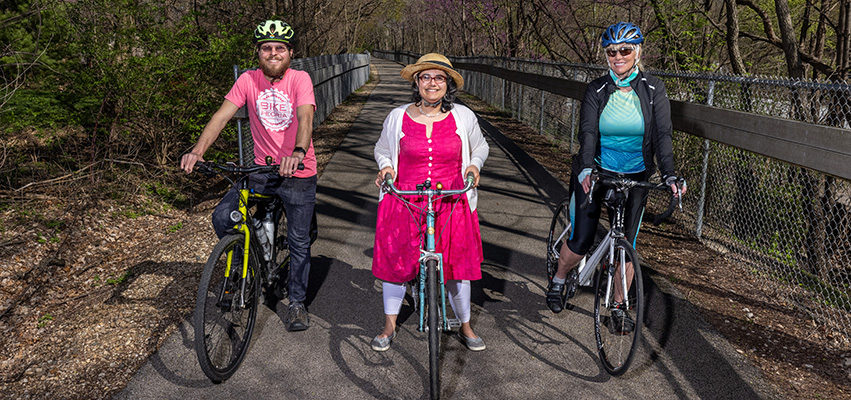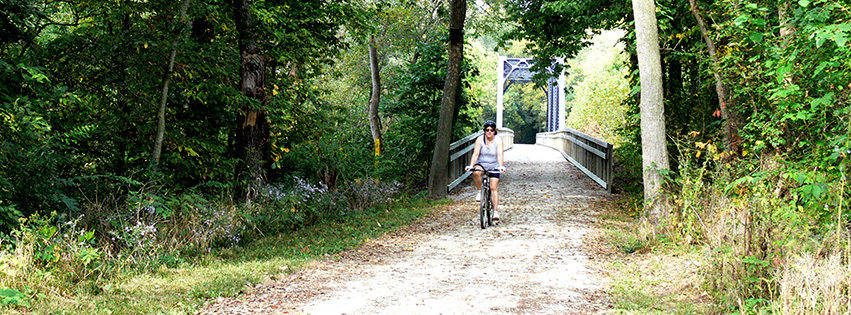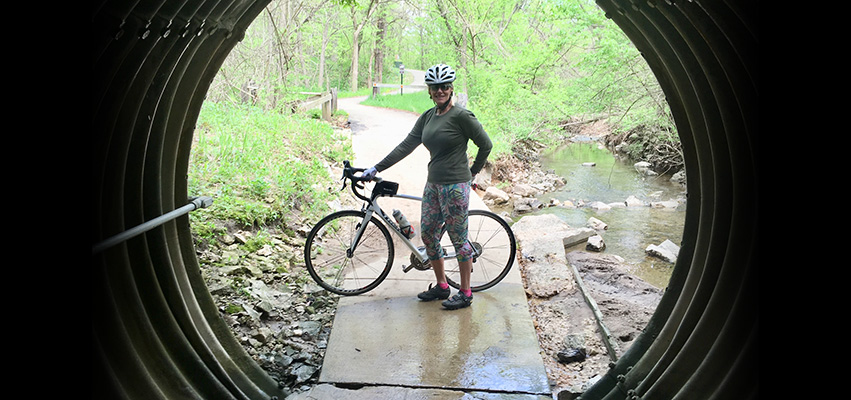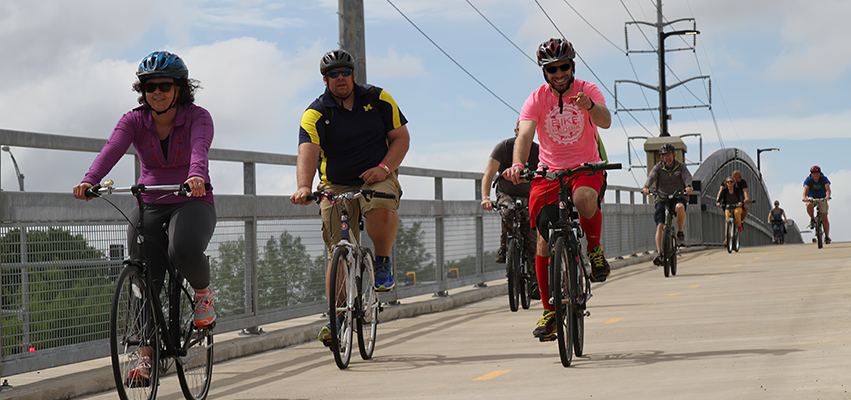
The poet Robert Frost once wrote, “Good fences make good neighbors.” We, the members of Trail Advocates of Central Illinois, believe that “Good trails also make good neighbors.”
Residents love trails. Surveys consistently show that people place parks and recreational trails high on their list of preferred amenities in a neighborhood. After all, a recreational trail is simply a “linear park,” or “greenway.”
One family I know purchased a home in the Trails Edge subdivision in north Peoria, located adjacent to the Rock Island Trail. Each member of the household hikes and bikes on the trail, and they are thrilled that their property backs up to it. “The attractive woodlands along the trail really made it an attractive site,” they stated. “We love the trail—and it was definitely a factor when we bought the lot.”
Trails attract new residents, increase property values, and contribute to healthful recreation for all ages. And with more people wishing to bike to work or to shop, vehicular traffic on roads and highways is reduced—with all the benefits that entails. Simply put: trails enrich communities and enhance quality of life.
Connecting the Region
With these ideas in mind, a group of civic-minded volunteers came together in 1981 to form the Friends of the Rock Island Trail. Under the leadership of George Burrier as president, the organization worked with governmental officials and communities to create the 26-mile Rock Island State Trail along an abandoned railroad line. The first segments opened in 1981—one of the first rail-trails in Illinois. George served in this position for nearly three decades. Without him and these enthusiastic volunteers, it is doubtful the trail would have come to fruition.
In 2015, the initial Rock Island Trail was lengthened by a 13-mile rail-trail along the former Kellar Branch rail line through Peoria and Peoria Heights. The Rock Island Greenway, as it is now called, extends from the west end of the Bob Michel Bridge through Peoria and Peoria Heights to the small community of Alta, just north of the city. There, it connects with the Rock Island State Trail—creating a 39-mile continuous trail which ends in the City of Toulon.

Meanwhile, at the east end of the Bob Michel Bridge, the 10-mile East Peoria to Morton Trail connects Peoria to its sister city across the river and extends all the way to Morton. This network of interconnected trails allows for a beautiful and adventurous 49-mile trail experience for the serious biker—along with plenty of shorter segments for the general population. Regardless of your experience or skill level, there’s something for everyone along the trail.
The Benefits of Trails
In addition to the myriad recreational and health benefits, trails bring incremental business to adjacent merchants and nearby businesses—and these dollars come from residents and visitors alike. In fact, “recreational tourism” is a growing industry in which bikers and trail enthusiasts travel to other communities and even other states to experience their trails. All of this adds up to a much broader slate of advantages for communities that invest in their trail system.
According to the Rails-to-Trails Conservancy, a national advocacy organization, “People tend to focus on the recreational or environmental aspects of trails and greenways, failing to see the big picture—the total package of benefits that a trail or greenway can provide to communities, including public health, economic and transportation benefits, and even the effect on community pride and identity.”
Over the past year, people both locally and around the country have tapped into this tapestry of benefits. According to the Conservancy, trail usage jumped by more than 200 percent during the pandemic, as people seek the recreational opportunities and solace that trails can provide. In a world of social distancing, trails have provided a vital connection to the outdoors.
For reasons of accessibility as well as economics, former railroad lines tend to provide the best opportunity for new recreational trails. These rail-trails make sense from every aspect. The Rails-to-Trails Conservancy has documented the average number of jobs created by the expenditure of one million dollars of public funds. Trails and greenways lead the way with 17 jobs created, versus 12.5 jobs for new highway construction, 11.5 jobs for bridge construction or replacement, and nine jobs for pavement improvement.

Another significant, yet often overlooked benefit of rail-trails is their function as a corridor for utilities. With their easy accessibility and streamlined land ownership, electrical and natural gas lines, fiber-optic cables, and even water and sewer lines are often placed along a trail right-of-way. If a former rail line were to be completely abandoned, these opportunities would be lost forever.
Opportunities and Enhancements
Today, there are more than 2,200 rail-trails throughout the United States, extending for a total of nearly 25,000 miles. Within Illinois alone, we have 83 rail-trails totaling 1,037 miles. Connecting these trails is a major goal of Trail Advocates of Central Illinois.
When George Burrier stepped down as president of the Friends of the Rock Island Trail in 2015, I was asked to assume that role. Besides the need for increased membership and community involvement, our organization’s efforts had expanded beyond the Rock Island Trail, so we needed a name to more aptly express this enhanced role. In 2019, the Friends of the Rock Island Trail merged with Bike Peoria and changed our name to Trail Advocates for Central Illinois.
“This has been a perfect fit for the two organizations,” notes Brent Baker, president of Bike Peoria. “We wanted to do more trail advocacy and volunteer work, and the Trail Advocates have brought us that capability.” With both organizations working together, we are better positioned to focus on new trail opportunities—as well as enhancing existing trails.
One significant potential rail-trail for the Peoria area is the 25-mile former Hanna City Railroad line. Running from Bellevue to Farmington, it was removed from service in 1980. Plans are now underway to purchase the right-of-way of this abandoned railroad and develop another rail-trail, which would be jointly owned by Peoria County, Hanna City and Farmington. Hanna City Mayor Fred Winterroth chairs this effort and has worked for 30 years to establish a trail along this corridor. A new volunteer effort called “Build the Hanna City Trail” has been established to pursue this goal.
Meanwhile, another potential trail running from Canton to Yates City would connect with the Hanna City Trail in Farmington. Connectivity begets connectivity, and all our communities are the beneficiary.
One major trail development will soon take place with the planned renovation of the railroad trestle crossing War Memorial Drive near the Peoria Journal Star building. This project will extend the Rock Island Greenway an additional half-mile to Park Avenue, eliminating the need for trail users to detour through Springdale Cemetery.

The new link will also provide access to NE Adams Street at the west end of the new McClugage Bridge, now under construction. A trailhead at that location will open access to the bridge, which was designed with a separate bicycle and pedestrian lane. The bridge link will extend across the river and potentially connect to the newly opened Sankoty Lakes recreational area in Spring Bay. Back on the Peoria side of the river, a proposed trail from the McClugage Bridge to the soon-to-be-revived Al Fresco Park would provide additional connections to our region’s growing network of recreational amenities.
Planning is also underway to develop a trailhead in Peoria Heights where the Rock Island Greenway crosses Prospect Road. A traffic counter has been installed along the trail near that intersection to demonstrate to nearby merchants and government officials that hundreds of bikers and pedestrians are using the trail each and every day. Daily traffic of more than 600 bikers, hikers and runners are regularly recorded by the traffic counter, providing hard data to make the case.
Building On a Rich History
Back in the 1890s, the Peoria area was a hub for bicyclists and bicycle production—producing more bicycles at that time than any other part of the country. Charles Duryea, who went on to produce some of America’s first gasoline-powered automobiles, was one of the major producers of bicycles in Peoria Heights. Many of those bicycles were made in the building now occupied by Trefzger’s Bakery, which is fittingly located adjacent to the Rock Island Greenway.
With the displacement of bicycles by automobiles, however, communities across the country started building their streets to accommodate cars—with little thought to accommodating bicycles. Peoria is now working to overcome this shortsightedness and once again become bike-friendly in the 21st century. “We got to a point where we were over-designing for the motor vehicle,” notes Nick Stoffer, Peoria city engineer. “Now when we do a road, we look at all users: pedestrians, bikes and buses.”
The City of Peoria is not only looking to make it easier to ride a bicycle on city streets, but also to nearby communities and beyond. In 2016, the City began forging a master bike plan in concert with the Tri-County Regional Planning Commission. The Heart of Illinois Regional Bicycle Plan identifies a proposed bicycle network within Peoria, Tazewell and Woodford counties—the first regional plan to connect communities via trails and strengthen bicycle transportation across the region.
The benefits of recreational trails are numerous and well-documented. They help create vibrant communities, and central Illinois is making great strides in this endeavor. We, the volunteers of Bike Peoria and Trail Advocates of Central Illinois, stand enthusiastic and ready to help our communities realize these benefits. PM
To become a member or for more information, visit bikepeoria.org/taci.
- Log in to post comments

